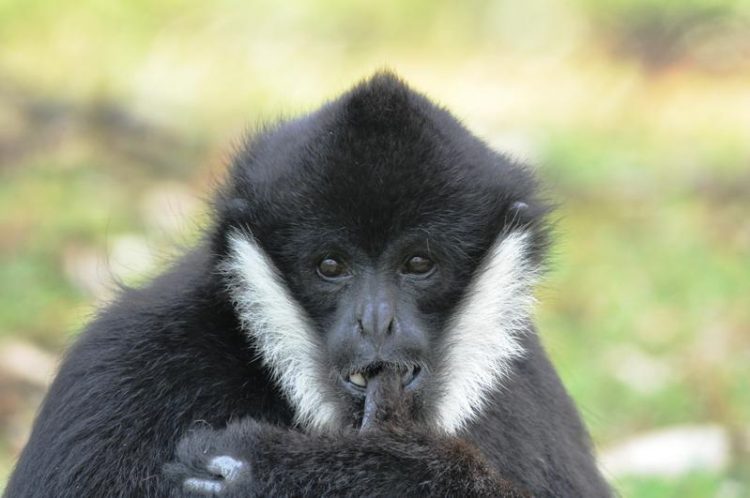Gibbon genome sequenced

Northern White-cheeked Gibbon male (Nomascus leucogenys) Image: Tilo Nadler
An international team of researchers that includes Christian Roos, Markus Brameier and Lutz Walter from the German Primate Center (DPZ) in Göttingen, have decoded the genome of gibbons from Southeast Asia. With this, the entire genetic information of five different species of this primate family has been sequenced for the first time.
Comparisons with the genome data of humans and our closest relatives, the great apes, show that while we all genetically have the same ancestors, the genetic information of the gibbons has changed more rapidly and stronger in the course of the evolutionary process.
The researchers could identify a new DNA element that only occurs in gibbons. This DNA element increases the mutation rate, and is thus of crucial importance for the evolutionary development. Thanks to the DNA element, the gibbon is also known as the one with the long, strong arms who elegantly moves through the forests of Southeast Asia. The study published in the current issue of Nature, allows important insights in the molecular fundamentals of the evolutionary process (Carbone et al. 2014)
The gibbons, known as small apes are genetically farther from humans than the great apes chimpanzees, bonobos, gorillas and orang-utans. In the genealogy of the evolutionary developments of primates, the gibbons do occupy a key position. In the course of the evolutionary process, they were the first to split from the hereditary line of the great apes and humans.
„The complete sequencing of the gibbon genome was pending until now“, says Christian Roos, a scientist from the Primate Genetics Laboratory at the DPZ. “In order to fully understand the human evolution and to draw conclusions on our evolutionary roots, we need to conduct phylogenetic research of our more distant relatives.“
Genetic disorder and jumping gene sections
In their genome analysis, the researchers discovered that the genetic information of the gibbons differs in their entirety from that of humans and of apes. “The genetic information itself is similar to ours”, explains Christian Roos. “However, large segments of DNA and in such, many genes are arranged differently on the individual chromosomes.” This “chromosomal disorder” is a key feature of the gibbon genome and has probably occurred after their secession from the ancestral line of the apes and humans.
Through further research on the gibbon DNA, scientists were finally able to identify a possible cause for these changes in the genome: A jumping DNA element called LAVA transposon can be copied and integrated elsewhere in the genome. So far, transposons or jumping genes have been detected in many different organisms. However, the LAVA transposon is unique to the gibbon genome.
The special feature of this DNA element is its positioning in precisely those genes that play a role in the chromosome distribution during cell division and thus influences them. Analyses of the phylogenetic development of the gibbon line also indicate a connection to the existence of the LAVA transposons. Their first appearance can be traced back with a high probability to the time of the splitting of the gibbons from the line of apes and humans.
Genetic basis for gibbon-specific way of life
Through comparative DNA analyses, the researchers could also identify genes subjected to a positive selection. In the course of evolution, genes that favored the adaptation of the gibbons to their way of life, continued to develop. These include genes responsible for anatomical specifications such as longer arms or stronger muscles. Gibbon genes, which have undergone a positive selection are, for example TBX5, which is required for the development of the front extremities and COL1A1, responsible for the development of the protein collagen. The latter is one of the main components of connective tissues in bones, teeth and tendons.
“These genes are positively selected only in the gibbon genome”, says Christian Roos. “In future projects, sequencing will be performed on other gibbon species. We hope to be able to further characterize these genes and to identify other gibbon-specific genes.”
Original publication
Carbone, L. et al. (2014): Gibbon genome and the fast karyotype evolution of small apes. Nature Epub ahead of print. DOI: 10.1038/nature13679
Contact
PD Dr. Christian Roos
Primate Genetics Laboratory
German Primate Center
phone +49 551 3851-300
e-mail: croos@dpz.eu
Dr. Susanne Diederich
Public Relations
German Primate Center
phone: +49 551 3851-359
E-Mail: sdiederich@dpz.eu
The German Primate Center (DPZ) – Leibniz Institute for Primate Research conducts biological and biomedical research with primates in infection research, neuroscience and primate biology. The DPZ maintains three field stations in the tropics and is the reference and service center for all aspects of primate research. The DPZ is one of 89 research and infrastructure facilities of the Leibniz Association.
http://medien.dpz.eu/webgate/keyword.html?currentContainerId=2301 – Printable images
http://www.dpz.eu/en/info-center/media-center/video.html – video (German language)
http://www.dpz.eu/en/news/news.html – DPZ website
Media Contact
All latest news from the category: Life Sciences and Chemistry
Articles and reports from the Life Sciences and chemistry area deal with applied and basic research into modern biology, chemistry and human medicine.
Valuable information can be found on a range of life sciences fields including bacteriology, biochemistry, bionics, bioinformatics, biophysics, biotechnology, genetics, geobotany, human biology, marine biology, microbiology, molecular biology, cellular biology, zoology, bioinorganic chemistry, microchemistry and environmental chemistry.
Newest articles

NASA: Mystery of life’s handedness deepens
The mystery of why life uses molecules with specific orientations has deepened with a NASA-funded discovery that RNA — a key molecule thought to have potentially held the instructions for…

What are the effects of historic lithium mining on water quality?
Study reveals low levels of common contaminants but high levels of other elements in waters associated with an abandoned lithium mine. Lithium ore and mining waste from a historic lithium…

Quantum-inspired design boosts efficiency of heat-to-electricity conversion
Rice engineers take unconventional route to improving thermophotovoltaic systems. Researchers at Rice University have found a new way to improve a key element of thermophotovoltaic (TPV) systems, which convert heat…



